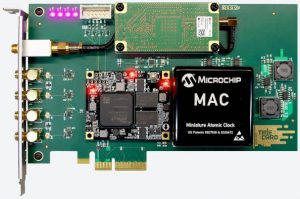
It combines frequencies from a miniature atomic clock and GPS receiver, both on the card, with FPGA-based qualification that combines the two. The local clock is there for when satellite signals are not available, or are unreliable – for example during a spoofing attack.
With it, “anyone with experience working with microelectronics can turn any PC built on an x86 architecture and featuring a network interface controller into a nanosecond-level-accurate timing and synchronisation solution”, according to Swiss GPS chip maker u-blox. “Easy access to nanosecond-level timing accuracy opens new avenues in industry segments that rely on highly synchronized signals, such as 5G network base stations that require tighter synchronization than those of previous generations. As power distribution networks become more complex to accommodate a growing share of decentralized renewable energy, they are becoming more reliant on reliable and accurate timing solutions. And following Facebook’s example, data centres and computer networks will be able to modernize infrastructure management to speed up performance and reduce latencies.”
U-blox is involved because it it its RCB-F9T timing board, built around its ZED-F9T GNSS receiver, that provides the off-air standard frequency.
Suggested atomic clocks come from Microchip (SA5X or SA.45s) or Orolia (mRO-50), and there are OCXO (SiT5711) and TCXO (SiT5356) options. The FPGA is a Xilinx Artix-7.
The board has coax connectors for the GNSS antenna at the rear of the host PC, as well as inputs and outputs for both 1Hz and 10MHz timing signals.
Facebook has a GitHub repository for Time Card information disclosure. It is part of the Open Compute Project (OCP) GitHub, under the Time Appliance Project (TAP).
Facebook Engineering has a web page discussing the card that is worth reading.